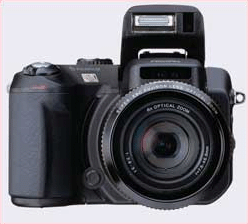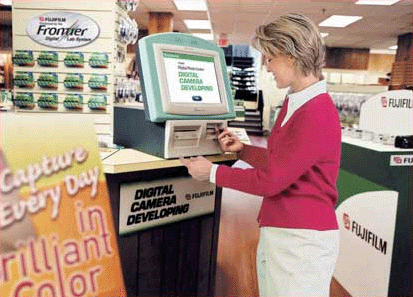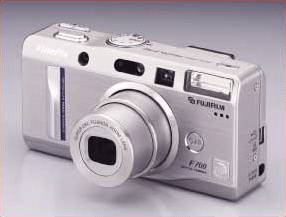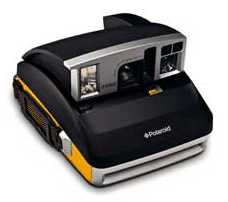Pixel Power: Using a Digital Camera to Your Advantage
 All photos courtesy of FuJi Photo Film U.S.A., Inc. |
As most businesses are, the masonry industry is very conscious of labor, time and money management. While there are not necessarily disadvantages to continuing to use film photography, digital cameras pose quite a few advantages that will help mason contractors get "from A to B" in less time and with less expense.
A Comparison
"We are certainly not opposed to people using film," explains Andrew LaGuardia, Senior Manager of Corporate Communications for Fujifilm USA. "While our future and current focus is really on digital and moving that category ahead, we'll remain committed to film. What it comes down to is which medium best meets the needs of the user."
Many users turn to digital cameras to meet several different needs.
Are your photographs not turning out quite how you thought they might? The benefit of being able to see the image on the LCD display will help you re-take a picture right away and get the shot you're looking for.
Are you spending a lot of money on film processing? Other than time spent downloading images from the camera to your computer, there are no "processing" costs. Also, you can print only the images you want on a high-quality printer at the home or office, or use a professional kiosk center, such as the Fujifilm Aladdin Digital Photo Center (see picture below), at your local photo processing store.
Are you digitizing images often? If you are currently e-mailing images or posting them on your web site, a digital camera will make the process easier. If not, would you and your business benefit from being able to have this option?
LaGuardia says that many of the advantages of digital can be utilized with the film medium, such as getting pictures digitized during processing, but there are several more steps between taking a picture on film and being able to look at it on your computer screen.
"With the digital medium, you don't have to go through those steps ? you already have the images digitized," he says.
 "I think that the biggest advantages are: the ability for instant feedback regarding the picture, so you know whether or not you got the shot that you wanted, simply by looking at the LCD display image on the back of the camera; the ability to delete a photo that did not end up the way you intended, you can go ahead and erase it and take another one; and, with the size of the media cards that are available at this time, going on to gigabyte sizes, you can take an awful lot of pictures with digital cameras. So when someone's down at the site, he or she would not have to be worried about only having a certain number of images left. They can just go ahead, if they have an empty media card, and most likely be able to fire away as many pictures as they want."
"I think that the biggest advantages are: the ability for instant feedback regarding the picture, so you know whether or not you got the shot that you wanted, simply by looking at the LCD display image on the back of the camera; the ability to delete a photo that did not end up the way you intended, you can go ahead and erase it and take another one; and, with the size of the media cards that are available at this time, going on to gigabyte sizes, you can take an awful lot of pictures with digital cameras. So when someone's down at the site, he or she would not have to be worried about only having a certain number of images left. They can just go ahead, if they have an empty media card, and most likely be able to fire away as many pictures as they want."
Also, most masonry construction sites get blazing hot during the summer months. While your crews are working in 80-, 90-, even 100-degree temperatures, the temperature in their vehicles can get up to 200 degrees, depending on the temperature outside, the kind of vehicle they have, and how long it has been in the sun. While most technology items, including photography products, don't fair well in above-normal heat, a digital camera might survive your foreperson leaving it in the car now and again.
"We don't recommend putting any photographic product in direct sunlight or heat, it can do a lot of damage," says LaGuardia. "Film is probably going to be a little more sensitive to atmospheric conditions, particularly heat, than a digital camera. That's not to say that digital cameras are indestructible ? anything electronic, you drop it and you're going to have some problems."
Finally, digital cameras can assist in initiative workflow, or the management of pictures.
"Let's say, for instance, that the foreperson has gone and taken 10, 20 or 30 pictures on a particular job site," LaGuardia poses. "Many of our digital cameras have docking stations, where they can go and drop the camera into the docking station [that loads the images onto your computer] and, in essence, you can go and take a look at all of the pictures that you have. From there, you can put the pictures in different folders, you can e-mail them directly off to some folks, and you can print them out. This particular process, in comparison to film where there are a couple of more steps involved, is far easier in most people's eyes."
Marketing Advantage
So what's the big deal with being able to have images in digital format, rather than hard copy pictures? Simply, the ability to benefit from easily sharing the images with others. Whether by e-mail, on CD, in a slideshow presentation in your booth at the next local builder show, or on your web site where hundreds of potential clients can view your latest and greatest masterpiece, digital photography makes sharing images much easier.
Although Jeff Klayman, Owner of Klayman Communications, prefers his 35mm camera to a digital camera, he doesn't deny the worth of easily being able to show others your talents in the trade.
"You don't have to specialize in marketing to realize that a picture is a tremendous selling tool," he says.
"Ed Glock, the Executive Director of the Masonry Institute of St. Louis, upgraded his black and white newsletter/magazine to full-color on good slick paper because he knew that beautiful images sell product," Klayman continues. "In the Excellence in Masonry Awards program, we produce a video that really shows off the beauty of the masonry projects. We also produce a full-color Excellence insert for the local business newspaper to hammer home our marketing message to the decision-makers' community in St. Louis. All these marketing tools rely on the strength of the images and are very effective in enhancing the image of masonry in the business community.
 "If a mason contractor has a web site or a company brochure, he or she is going to want to feature their best-looking projects. If they're going to sit down for a face-to-face meeting, the mason contractor might want a portfolio of attractive 8" x 10" photos. We're talking image here, and drug store-developed 4" x 6" shots just don't show off masonry projects like a good, well-shot enlargement."
"If a mason contractor has a web site or a company brochure, he or she is going to want to feature their best-looking projects. If they're going to sit down for a face-to-face meeting, the mason contractor might want a portfolio of attractive 8" x 10" photos. We're talking image here, and drug store-developed 4" x 6" shots just don't show off masonry projects like a good, well-shot enlargement."
While you may be able to create some excellent images on your own with your digital camera, you shouldn't let that go to your head. Like many other things, there's a time and a place when hiring a professional is the best move.
"In awards competitions, the photography is vital," stresses Klayman. "Images connect with the emotions a lot faster and more effectively than words. It's not that a poorly shot project can't win, it's just that you're competing with a terrible handicap if your entry photos fail to portray the beauty of your project. Don't ask the judges to imagine how beautiful the project is ? show them.
"Think of it as a Miss America Pageant where the best looking contestant comes out with no makeup, a frumpy hair style and a bag lady outfit. She's beautiful, but it's really hard to see it."
Digital Camera Features
Although there's an endless list of available features you can find on digital cameras nowadays, here are a few main features to look for when purchasing a digital camera:
Megapixels
Pixels are essentially a dot in an image ? the higher the pixel count, the more dots there are and the sharper the image will look. Therefore, the higher the number of megapixels (or 1 million pixels), the better the image quality that you will get from the camera. Although digital technology is changing every day, at the time of this writing, consumer digital cameras are available with three to six megapixels, with higher-priced professional models ranging up to 13 megapixels.
"Depending on what type of pictures you're going to be taking, in terms of what size print you're going to want, that's where the megapixels come into play," says LaGuardia. "You'll probably find a three- or four-megapixel camera will work fine if you're going to be doing 4x6 and 5x7 prints ? you could probably get away with even an 8x10 print. If you find that you need to take that picture and really blow it up, at that point you're going to be looking for a five- or six-megapixel camera."
Lens Capabilities
Most digital cameras come with a multi-functional, well-rounded lens that will allow you to capture close-up (i.e., macro), wide-angle, average and long-range (i.e., zoom or telephoto) pictures. Mason contractors will have a great use for macro capabilities to capture fine details, such as the top anchor steel plate and nut used in prestressed masonry or to document cracks before a renovation project. You'll also find a good wide-angle capability useful for getting an entire building in one shot.
Optical Zoom
"There's a difference between an optical zoom and a digital zoom," LaGuardia explains. "An optical zoom is going to bring you closer to your subject. It's like a standard zoom lens that everyone understands. However, a digital zoom essentially takes the image and blows it up, making the image not as sharp. So, an optical zoom is important, at least a 3x optical zoom. Some of our cameras go up to 6x, even 10x, but a 3x optical zoom is pretty good."
Accessories Standard accessories that any digital camera can utilize include tripods, a high-quality photo printer, rechargeable batteries and more. However, sometimes the things that separate one product from another are the camera-specific accessories available and how much you can tailor that product to best fit your needs.
"There are some cameras that allow you to purchase a housing that will make them water- and dust-proof," says LaGuardia. "That would be something that might be an excellent addition for mason contractors."
Other items that might come in handy for the construction site include lens adapters or filters.
Lens adapters allow the user to push the camera beyond the capabilities of the lens, making super close-ups, even wider wide-angle and longer telephoto pictures possible.
Filters are pieces of glass or plastic that screw to the front of the lens allowing the user to correct a problem or change the environment before the photograph is even taken. While some are more practical than others, there are hundreds of filters to choose from.
"A polarizing filter is of critical importance," Klayman states. "Sun bouncing off masonry into your lens will produce a photo where the colors of the brick are washed out. The polarizer filters out the sun and allows vivid colors and sharp contrasts, elements that are vital for a good photo. If the mason contractor has a digital camera, he or she really needs one that will take a polarizing filter. It's that important."
Despite the features that suit you the best, you are bound to find a camera that will fit your requirements.
"What we like to say is that, regardless of who you are as a photographer, we definitely have the camera that is right for you and meets your specific needs," says LaGuardia.
Blast from the Past
 Not really feeling technologically savvy? Do you need a camera that can document on-site details or before-and-after shots for your files without all the bells and whistles? Rather than purchasing something that's more than what you need, the Polaroid One600 JobPro might be the answer you're looking for.
Not really feeling technologically savvy? Do you need a camera that can document on-site details or before-and-after shots for your files without all the bells and whistles? Rather than purchasing something that's more than what you need, the Polaroid One600 JobPro might be the answer you're looking for.
Like most Polaroid cameras, the JobPro features simple point-and-shoot operation, a focus-free lens, auto flash and the new AutoSharp technology for capturing detailed shots as close as two feet away.
What makes this camera special is that it was specifically designed for construction site photography. The JobPro's casing is reinforced for durability to withstand tough work conditions, the rubberized finish lends to a no-slip grip, and a scratch-resistant shield protects the lens from dust, dirt and flying mortar. It also comes with a limited lifetime warranty that covers most repairs and replacement if it's ever damaged.
The camera has a suggested retail price of $59, but some of the online retailers we've checked are selling it for $39. The JobPro utilizes standard Polaroid 600 Film, 600 NotePad Film (gives you extra lines at the bottom of the frame so you can write notes) or 600 Write-On Film (a matte-finished film that allows you to write directly on the image) that sell for about $14.99 per pack.
For more information about the Polaroid One600 JobPro camera, visit www.polaroid.com/jobpro.
About the Author
Jennie Farnsworth is an Atlanta-based freelance writer and editor. She is a former editor of Masonry magazine.


















